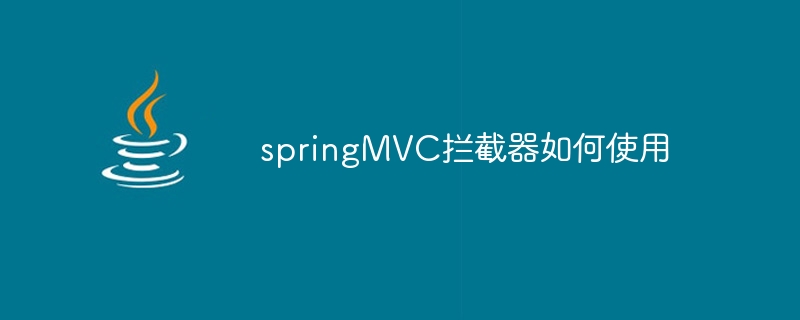Home >Java >javaTutorial >How to use springMVC interceptor
How to use springMVC interceptor
- 小老鼠Original
- 2024-01-10 15:42:35736browse
Usage steps: 1. Create an interceptor class: Create a class to implement the HandlerInterceptor interface. This interface contains three methods, namely preHandle, postHandle and afterCompletion; 2. Register the interceptor: Register the interceptor in the Spring MVC configuration, which can be done through Java configuration or XML configuration; 3. Use the interceptor: Interceptor configuration Once completed, it will intercept the request on the specified path and perform the corresponding tasks.

Operating system for this tutorial: Windows 10 system, Dell G3 computer.
In Spring MVC, the interceptor (Interceptor) is a mechanism used to perform some tasks before and after request processing. Interceptors can be used to handle various tasks such as logging, permission verification, and internationalization. The following are the general steps on how to use interceptors in Spring MVC:
1. Create the interceptor class:First, You need to create a class that implements the HandlerInterceptor interface. This interface contains three methods, namely preHandle, postHandle and afterCompletion. You can optionally implement these methods to perform pre-request, post-request, and post-view-rendering tasks.
import javax.servlet.http.HttpServletRequest;
import javax.servlet.http.HttpServletResponse;
import org.springframework.web.servlet.HandlerInterceptor;
import org.springframework.web.servlet.ModelAndView;
public class MyInterceptor implements HandlerInterceptor {
@Override
public boolean preHandle(HttpServletRequest request, HttpServletResponse response, Object handler) throws Exception {
// 在请求处理之前执行
return true; // 返回true表示继续执行后续操作,返回false表示中断请求
}
@Override
public void postHandle(HttpServletRequest request, HttpServletResponse response, Object handler, ModelAndView modelAndView) throws Exception {
// 在请求处理之后执行,但在视图渲染之前
}
@Override
public void afterCompletion(HttpServletRequest request, HttpServletResponse response, Object handler, Exception ex) throws Exception {
// 在视图渲染之后执行
}
}2. Register the interceptor: Register the interceptor in the Spring MVC configuration. This can be done via Java configuration or XML configuration.
Java configuration method:
import org.springframework.context.annotation.Configuration;
import org.springframework.web.servlet.config.annotation.InterceptorRegistry;
import org.springframework.web.servlet.config.annotation.WebMvcConfigurer;
@Configuration
public class WebConfig implements WebMvcConfigurer {
@Override
public void addInterceptors(InterceptorRegistry registry) {
registry.addInterceptor(new MyInterceptor()).addPathPatterns("/secure/**");
}
}XML configuration method:
<mvc:interceptors>
<mvc:interceptor>
<mvc:mapping path="/secure/**"/>
<bean class="com.example.MyInterceptor"/>
</mvc:interceptor>
</mvc:interceptors>The addPathPatterns here specifies the path to be intercepted by the interceptor, which can be configured as needed.
#3. Use interceptors: After the interceptor is configured, it will intercept requests on the specified path and perform corresponding tasks. In the above example, the interceptor will be executed on the request with the path "/secure/**".
#The use of interceptors can flexibly meet the needs of different scenarios, such as permission control, logging, etc. Note that in the interceptor, pay attention to returning true or false to control whether to continue executing the request processing chain.
The above is the detailed content of How to use springMVC interceptor. For more information, please follow other related articles on the PHP Chinese website!

